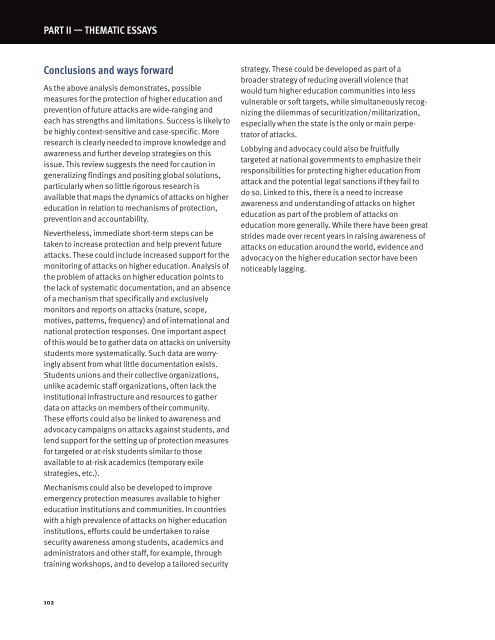You also want an ePaper? Increase the reach of your titles
YUMPU automatically turns print PDFs into web optimized ePapers that Google loves.
PART II — THeMATIC eSSAYS<br />
Conclusions and ways forward<br />
As the above analysis demonstrates, possible<br />
measures for the protection of higher education and<br />
prevention of future attacks are wide-ranging and<br />
each has strengths and limitations. Success is likely to<br />
be highly context-sensitive and case-specific. More<br />
research is clearly needed to improve knowledge and<br />
awareness and further develop strategies on this<br />
issue. This review suggests the need for caution in<br />
generalizing findings and positing global solutions,<br />
particularly when so little rigorous research is<br />
available that maps the dynamics of attacks on higher<br />
education in relation to mechanisms of protection,<br />
prevention and accountability.<br />
Nevertheless, immediate short-term steps can be<br />
taken to increase protection and help prevent future<br />
attacks. These could include increased support for the<br />
monitoring of attacks on higher education. Analysis of<br />
the problem of attacks on higher education points to<br />
the lack of systematic documentation, and an absence<br />
of a mechanism that specifically and exclusively<br />
monitors and reports on attacks (nature, scope,<br />
motives, patterns, frequency) and of international and<br />
national protection responses. One important aspect<br />
of this would be to gather data on attacks on university<br />
students more systematically. Such data are worryingly<br />
absent from what little documentation exists.<br />
Students unions and their collective organizations,<br />
unlike academic staff organizations, often lack the<br />
institutional infrastructure and resources to gather<br />
data on attacks on members of their community.<br />
These efforts could also be linked to awareness and<br />
advocacy campaigns on attacks against students, and<br />
lend support for the setting up of protection measures<br />
for targeted or at-risk students similar to those<br />
available to at-risk academics (temporary exile<br />
strategies, etc.).<br />
Mechanisms could also be developed to improve<br />
emergency protection measures available to higher<br />
education institutions and communities. In countries<br />
with a high prevalence of attacks on higher education<br />
institutions, efforts could be undertaken to raise<br />
security awareness among students, academics and<br />
administrators and other staff, for example, through<br />
training workshops, and to develop a tailored security<br />
strategy. These could be developed as part of a<br />
broader strategy of reducing overall violence that<br />
would turn higher education communities into less<br />
vulnerable or soft targets, while simultaneously recognizing<br />
the dilemmas of securitization/militarization,<br />
especially when the state is the only or main perpetrator<br />
of attacks.<br />
Lobbying and advocacy could also be fruitfully<br />
targeted at national governments to emphasize their<br />
responsibilities for protecting higher education from<br />
attack and the potential legal sanctions if they fail to<br />
do so. Linked to this, there is a need to increase<br />
awareness and understanding of attacks on higher<br />
education as part of the problem of attacks on<br />
education more generally. While there have been great<br />
strides made over recent years in raising awareness of<br />
attacks on education around the world, evidence and<br />
advocacy on the higher education sector have been<br />
noticeably lagging.<br />
102



